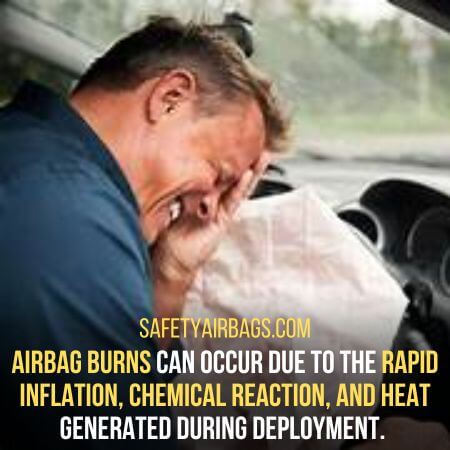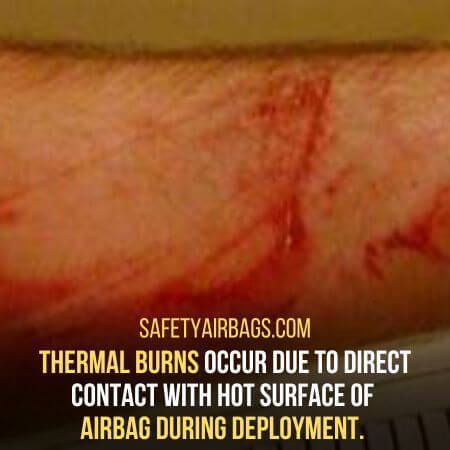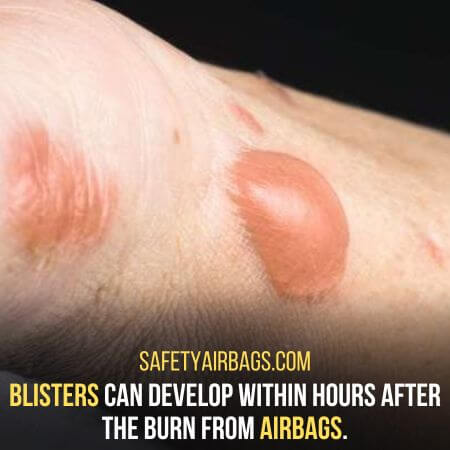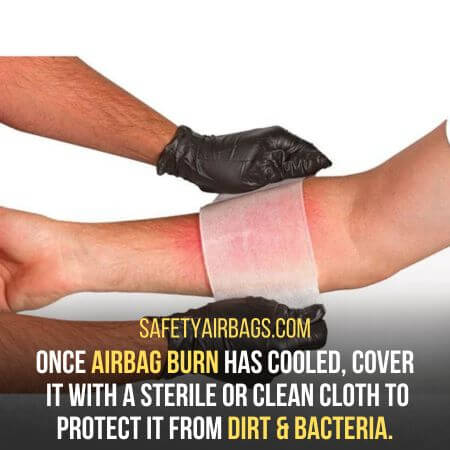Airbag burns can occur due to the rapid inflation, chemical reaction, and heat generated during deployment.
What Will I learn
The burns can be thermal, chemical, or friction-related, with varying degrees of severity. Immediate medical attention is crucial.
Causes of Airbag Burns
Causes of airbag burns include the rapid inflation of the airbag, the chemical reaction involved in airbag deployment, and the heat generated during the inflation process.

These factors can lead to contact burns, friction burns, and thermal burns on the skin.
1. Rapid inflation:
When a vehicle experiences a collision or significant deceleration, the airbag system is triggered, leading to the rapid inflation of the airbag.
This inflation occurs within milliseconds and is designed to provide a cushioning effect to protect the occupants.
However, the force involved in the rapid deployment can cause injuries, including burns.
2. Chemical reaction:
Airbags rely on a chemical reaction to inflate and provide protection rapidly.
The system consists of a sensor that detects a collision or deceleration, an igniter, and a fuel.
When the sensor detects a collision, it sends an electrical signal to the igniter, which initiates the chemical reaction.
The propellant, typically sodium azide (NaN3), undergoes a rapid exothermic reaction with other chemicals, such as potassium nitrate (KNO3) or ammonium nitrate (NH4NO3).
This chemical reaction produces a large volume of gas, primarily nitrogen, which inflates the airbag.
3. Heat generated:
During the rapid inflation of the airbag, heat is generated as a byproduct of the chemical reaction.
The energy released by the exothermic reaction raises the temperature of the gases within the airbag.
This heat and aggressive expansion can increase the risk of burns upon contact.
The temperature of the airbag during deployment can vary depending on several factors.
This can include the fuel’s specific chemical composition, the airbag’s size, and design environmental conditions.
Types of Airbag-Related Burns
Airbag-related burns can be classified into three types: thermal, chemical, and friction.
Each type of burn may vary in severity, with thermal burns typically affecting the outer layers of the skin,
chemical burns involving exposure to corrosive substances, and friction burns resulting in abrasions and skin irritation.
Treatment approaches depend on the specific type and severity of the burn.
1. Thermal burns:
Thermal burns are a type of airbag-related burn that occurs due to direct contact with the hot surface of the airbag during deployment.
As the airbag rapidly inflates, it can become heated due to the chemical reaction and the energy released.

The temperature of the airbag can vary, but it can potentially cause burns upon contact.
Thermal burns typically occur when the skin directly interacts with the hot airbag surface.
The severity of thermal burns depends on factors such as the duration of contact, the temperature of the airbag, and the sensitivity of the individual’s skin.
2. Chemical burns:
Chemical burns can occur when an individual comes into direct contact with the chemicals used in airbag inflation.
While the primary purpose of these chemicals is to inflate the airbag rapidly, they can be corrosive or irritating to the skin.
The severity of chemical burns can vary depending on the concentration and nature of the chemicals involved.
Chemical burns may result from a rupture or tear in the airbag, which exposes the individual to the propellant chemicals.
The burns can range from mild irritation and redness to more severe damage, depending on the duration and intensity of exposure.
3. Friction burns:
Friction burns are another type of airbag-related burn that can occur during deployment. As the airbag rapidly inflates,
it can come into forceful contact with the skin, especially if the occupants are not properly positioned or restrained.
The airbag and skin friction can lead to abrasions and burns.
Friction burns may occur when the airbag rubs against the skin, face, arms, or chest.
These burns are typically characterized by redness, skin irritation, and superficial abrasions. While friction burns may be less severe than thermal or chemical burns,
they can still cause discomfort. They may require medical attention, particularly if the skin is broken or if signs of infection develop.
The Severity of Airbag Burns
Airbag burns can vary in severity, from superficial to partial and full-thickness burns.
These burns often require surgical intervention and can result in significant scarring and long-term complications.
The severity of airbag burns depends on factors such as the duration of contact, temperature, and individual factors.
1. Superficial burns:
Superficial burns, first-degree burns, are the mildest form of airbag-related burns.
These burns typically affect the outermost layer of the skin, known as the epidermis. Common symptoms include redness, pain, and mild swelling.
Superficial burns may resemble sunburn and usually heal within a few days to a week without scarring.
They can often be treated with simple first aid measures such as cool water application, over-the-counter pain relievers, and soothing creams or ointments.
2. Partial-thickness burns:
Partial-thickness burns, also referred to as second-degree burns, are more severe than superficial burns.
These burns extend beyond the outermost layer of the skin and may reach the deeper dermis layer.

Symptoms include blistering, intense pain, redness, swelling, and a wet or weeping appearance.
Blisters can develop within hours after the burn. Partial-thickness burns require proper medical evaluation and treatment.
3. Full-thickness burns:
Full-thickness or third-degree burns are the most severe type of airbag-related burns.
These burns penetrate through all layers of the skin and can reach underlying tissues such as muscles, tendons, or bones.
The affected area may appear charred, white, or leathery. Full-thickness burns often result in numbness due to nerve damage and are generally painless.
These burns necessitate immediate medical attention and typically require surgical intervention.
Treatment may involve wound cleaning, removal of dead tissue, skin grafting, and potentially long-term rehabilitation and reconstructive procedures.
The recovery from full-thickness burns can be extensive, and scarring is common.
Treatment of Airbag-Related Burns
When it comes to the treatment of airbag-related burns, seeking immediate medical help is crucial.
First aid measures can be taken initially, such as cooling the burn with cool water and covering it with a clean cloth.
However, professional medical interventions are often necessary.
Treatment may involve wound cleaning, dressing changes, pain management, and potential surgical interventions for severe burns.
1. Immediate response:
When dealing with airbag-related burns, it is crucial to seek immediate medical attention.
Even if the burn initially appears minor, it is important to have it evaluated by a healthcare professional.
Timely medical intervention can help prevent complications and ensure appropriate treatment.
2. First aid measures:
In the immediate aftermath of an airbag-related burn, certain first aid measures can be taken to alleviate pain and reduce the risk of infection:
2.1 Cooling the burn:
Use cool (not cold) running water or a cold compress to cool the burn for 10 to 20 minutes.
This helps to lower the skin temperature, reduce pain, and prevent further tissue damage.
2.2 Covering the burn:
Once the burn has been cooled, cover it with a sterile or clean cloth to protect it from dirt and bacteria.

Avoid using adhesive bandages directly on the burn.
2.3 Avoiding home remedies:
Refraining from applying home remedies such as butter, toothpaste, or oils to burn is essential.
These substances can increase the risk of infection and hinder proper healing.
3. Medical interventions:
For more severe airbag burns or burns that cover a large area of the body, professional medical interventions may be necessary:
3.1 Wound cleaning:
A healthcare professional will clean the burn thoroughly. They can remove debris, dead tissue, and bacteria. This helps reduce the risk of infection.
Proper cleaning is necessary for the infection to not spread.
3.2 Dressing changes:
Depending on the severity of the burn, the dressing may need to be changed regularly.
It is mandatory to maintain a clean and moist environment for optimal healing.
3.3 Pain Management & Antibiotics:
Medications may be prescribed to manage pain associated with the burn.
AAntibiotics may be prescribed to prevent or treat bacterial growth if there is a risk of infection.
3.4 Tetanus shot:
If the individual’s tetanus immunization is not current, a tetanus shot may be administered to prevent tetanus infection.
3.5 Surgical intervention:
In cases of deep or severe burns, surgical procedures such as skin grafting or debridement (removal of dead tissue) may be necessary to promote healing and prevent complications.
3.6 Rehabilitation:
Depending on the extent and location of the burn, rehabilitation therapies such as physical or occupational therapy may be recommended to restore functionality and promote recovery.
It is important to follow the guidance and treatment plan healthcare professionals provide.
They can ensure proper healing and minimize the risk of complications associated with airbag-related burns.
Conclusion:
Airbag-related burns are a potential consequence of airbag deployment in vehicle accidents.
Understanding these burns’ causes, types, and severity is crucial in providing appropriate treatment and care for those affected.
The causes of airbag burns include the rapid inflation of the airbag, the chemical reaction involved in inflation, and the heat generated during the process.
These factors can result in thermal burns from direct contact with the hot airbag surface.
There can be chemical burns from exposure to inflation chemicals and friction burns from the interaction between the airbag and the skin.
